Winterthur's Follies: Exhibit designed to highlight changing landscape
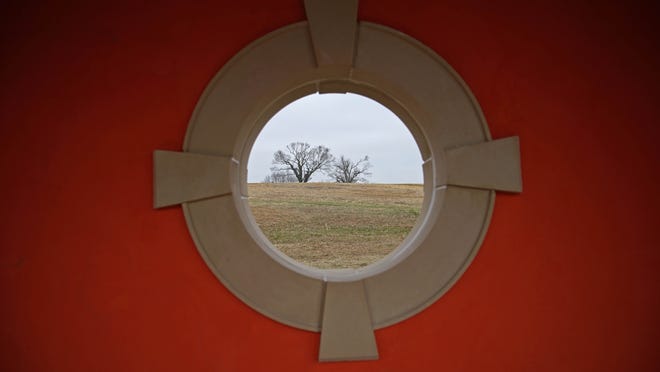
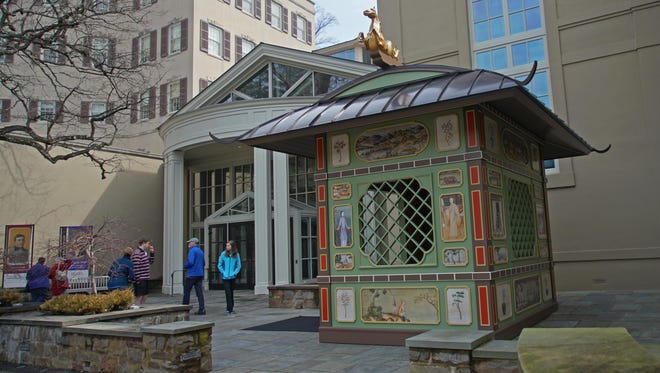
Winterthur Museum, Garden and Library organizers hope their new exhibit of garden structures will be the outdoor equivalent of its ragingly successful "Downton Abbey" costume exhibit.
That Downton show, which crushed attendance records in 2014, entwined the real-life story of Winterthur founder H.F. du Pont and his country estate with the fictional Crawley family and their estate from the popular PBS series.
The garden exhibit has its roots in the Downton one, says Chris Strand, Winterthur's Brown Harrington director of garden and estate. The museum then surveyed people about what they liked, and many said they would come back for garden events. Winterthur Executive Director David Roselle asked Strand if he'd ever considered a garden exhibit and sent him some ideas.
They decided to focus on follies, which are structures such as gazebos placed in the garden to add visual order or interest. To up the ante, they created seven to add to the six that H.F. du Pont included in his gardens as he built them.
"A story in a story," Strand says.
"Follies: Architectural Whimsy in the Garden" opened April 1, offering visitors a one-mile track they can walk in about 45 minutes or ride through on trams to see the 13 follies, which include a Gothic-inspired tower, a bright-red Ottoman tent, a Chinese house cribbed from an English estate and the estate's own fairie cottage.
A folly is placed in a garden primarily for decoration. But they also provide a focal point as well as amuse the observer, frame a vista or create a destination for visitors, Winterthur says in a release. It offers a far more erudite definition than an online one cited by Google that described a folly as "a costly ornamental building with no practical purpose, especially a tower or mock-Gothic ruin built in a large garden or park."
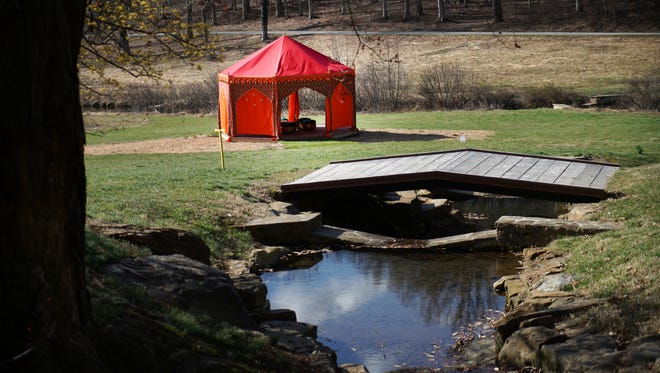
Strand says Winterthur experts researched its own follies as well as the history of follies, including a trip to English gardens, before settling on what it would add.
Planners settled on the unlucky number of 13 as the design was taking shape.
"One of the goals of the project was to get people to go through the garden," Strand said. "We sort of draped them like the numbers around the edge of a clock, spacing them so they weren't too close but not so far apart so it wasn't like, 'Oh, my gosh. We need to walk that far?'"
Winterthur has more structures that could be called follies, but they are away from the one-mile circuit. And they were careful not to install anything in what Strand calls the "sacred space" of places like the March Bank or Sundial Garden.
Some of Winterthur's existing follies are historical, moved by H.F. du Pont from one place to the estate the Latimeria Summerhouse from a Delaware estate and the 1750 House, which was the facade of an old New Castle, Delaware, home.
du Pont was well traveled, university-educated in horticulture and worked closely on garden design with childhood friend and architect Marian Coffin to place pieces to draw attention to particular views.
The estate is not alone in incorporating follies in Delaware. A massive folly stretches from side to side in the garden of Nemours Mansion and Estate. Others in the area include a pavilion at the end of a long allee of tall cypress at Gibraltar and the cast iron gazebo at Mt. Cuba's pond.
Winterthur's follies will be placed in a way to give visitors a good look at about 75 acres of the garden and surrounding area, only a small swath of the 1,000-acre estate.
A new app that details the follies and their route uses GPS to tell visitors exactly where they are standing and "to make it easier for people — well, to make it easier for teenagers — to navigate," Strand jokes.
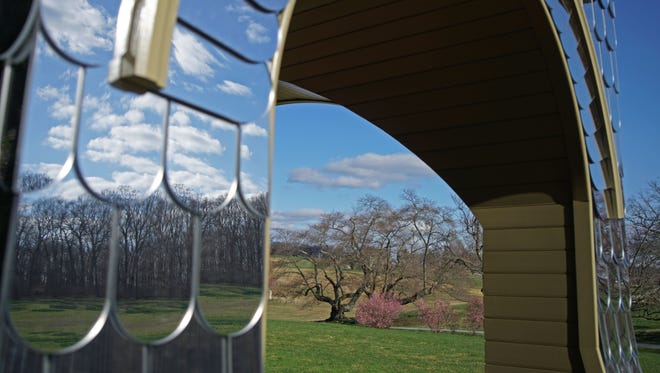
The new follies include:
• The Needle’s Eye, inspired by an 18th century in Yorkshire, England, and located on pond near the main drive.
• A Neoclassical Folly made to look like the entrance of a Greek temple or public building.
• A Mirrored Folly, which reflects the surrounding Pinetum and is inspired by the covered entrance of the estate's historic train station.
• A brilliant red Ottoman Tent inspired by Turkish tents and similar to 18th-century tents seen in England, France and Northern Europe.
• A gothic tower that mimics the towers, sham castles and fake ruins popular in European landscapes in the 1700s and 1800s.
• A Chinese Pavilion, inspired by the Chinese House at Stowe Landscape Garden in Buckinghamshire, England, but updated with illustrations taking from the wallpaper in Winterthur's Chinese Parlor.
• A Green Folly, built with Winterthur tree trunks, beech twig thatching and other woodland embellishments.
Curator Carol Long is betting on the Neoclassical Folly to provide the best views, both to it and from it, providing a contrast from its formal design and the always evolving natural world.
The view of it from the Winterhazel Walk now blooming in purples and golds should be wonderful, says Long, who helped plan the exhibit and traveled to England to research follies there.
Once at the temple, she said, the view of a large white oak tree in the meadow should be inspiring. And from the oak tree looking back at the temple, viewers will have a spectacular view of the garden with the cherry trees and March bank are in full blossom and the azaleas flowering near Mother's Day.
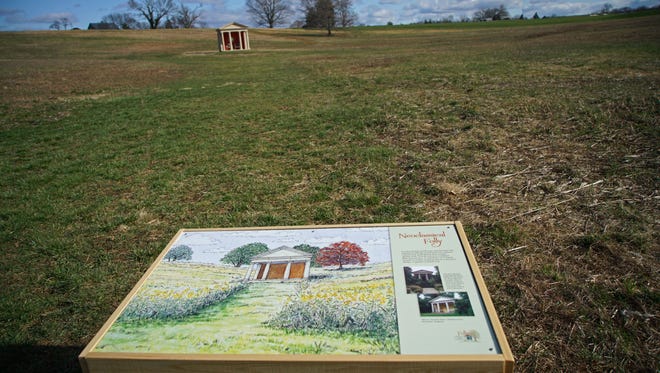
Joining the tour are these seven Winterthur follies:
• The Latimeria Summerhouse, set in the Peony Garden in 1929 after being saved from destruction in Wilmington.
• The Umbrella Seat and Pagoda Gate, which are also from Latimeria and greet visitors as they enter the garden from the Visitor Center.
• The 1750 House, a facade of a historic house from New Castle, Delaware that moved to Winterthur in the 1960s.
• The Brick Lookout, which includes the tin roof and cast iron eagle of a former shed that stood at the entrance court for the museum in the 1940s and 1950s.
• The Bristol Summerhouse, found Sycamore Hill, was re-created by H.F. du Pont based on a structure he had seen at The Lindens in Bristol, Rhode Island.
• The Faerie Cottage, built with repurposed items from the estate in the children's Enchanted Woods.
Long says the planners expect the follies to express themselves differently as the time of day and the seasons change.
"For example, yesterday coming in to work we were in a fog, and I was so excited to come in and see the needle floating in the pond," she says. "It was that moment when fog was coming in and that gave it a whole different look."
The Neoclassical Folly, for example, will have paths mowed to it through the meadow.
"When the grasses are tall and the wind is blowing, it will be a special moment looking at the folly and looking away from the folly," she said. "When the goldenrod turns yellow. I think there will be moments when they are particularly enticing."
KEEP READING
How to know when to change spices in cabinet
Contact Betsy Price at (302) 324-2884 or beprice@delawareonline.com.
If you go
WHAT: Follies: Architectural Whimsy in the Garden
WHERE: Winterthur Museum, Gardens and Libary, 5105 Kennett Pike, Winterthur, Delaware
WHEN: Daily, through Jan. 5, 2020. Museum opens at 10 a.m. Tuesday through Sunday. During the exhibition, the garden will be open until dusk.
TICKETS: Included in admission; $20 adults; $18 students and seniors; $6 ages 2-11;.
FOR MORE INFORMATION: winterthur.org; (800) 448-3883.
OF NOTE: The main path through the garden is wheelchair and stroller accessible.
SPECIAL PROGRAMS: Landscape historian John Dickson Hunt will lecture about follies April 21; Daffodil Days on April 14 and other Winterthur events will incorporate the follies; Summer Solstice party June 21 will be a progressive cocktail party throughout the follies.